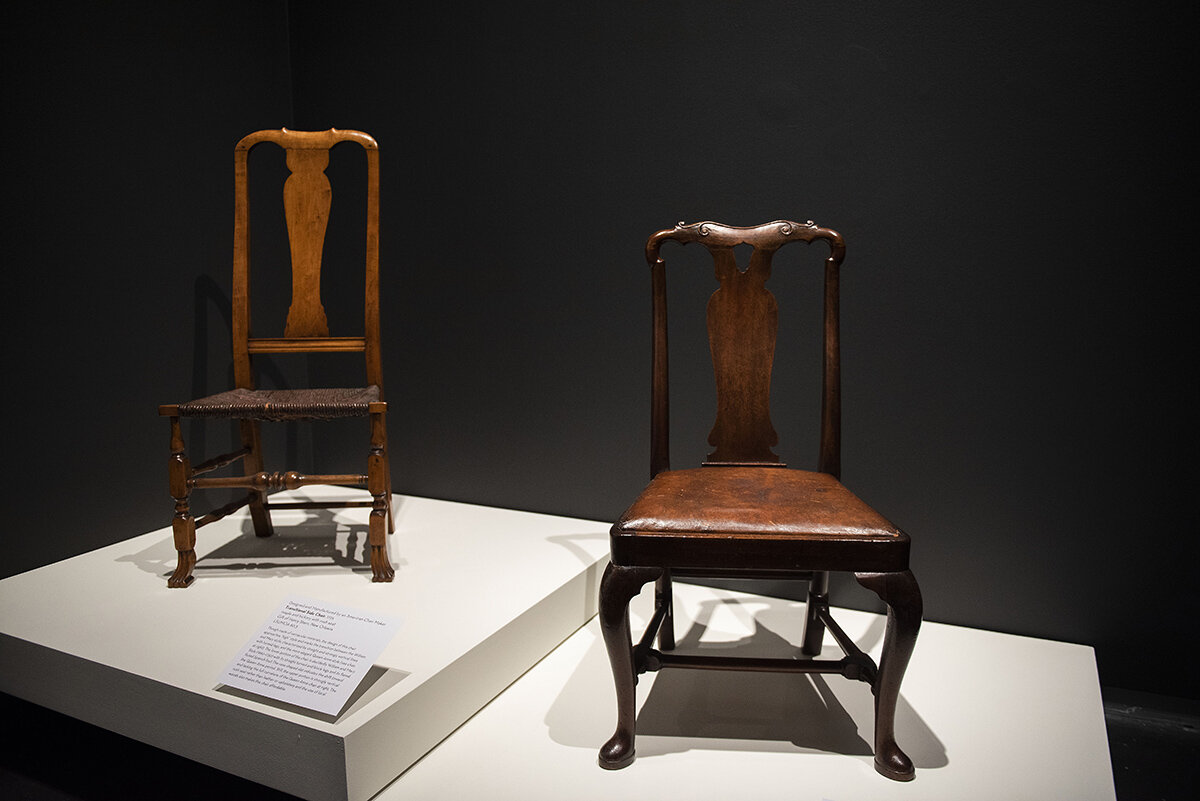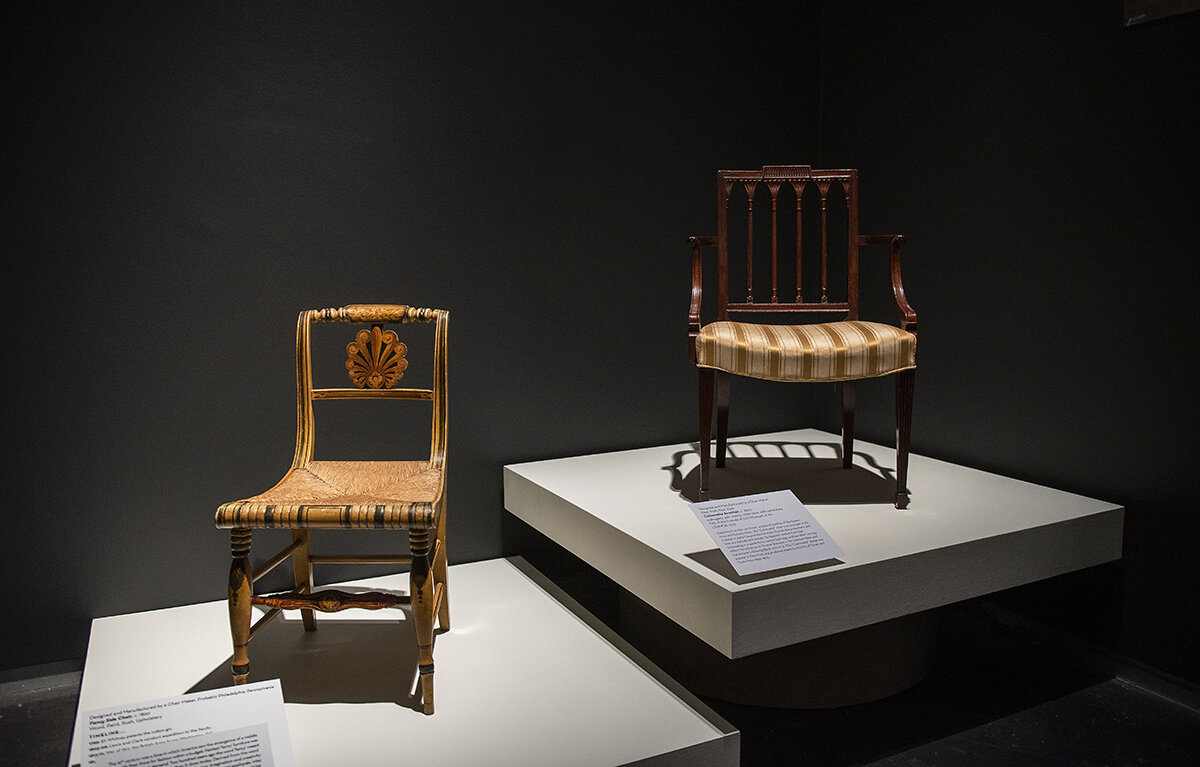Our current exhibition, The Art of Seating: Two Hundred Years of American Design offered us a great opportunity to exhibit chairs from LSU MOA’s own permanent collection. By including chairs from our collection, LSU MOA was able to effectively expand The Art of Seating to include an additional 100 years of American Design, extending the exhibition designs back to 1710.
Though the four chairs added represent American design and craft, the years 1710–1810 were heavily influenced by European design and particularly British design—we were a British colony for most of this period after all. French, Dutch, or even far Eastern influences appeared, but were filtered through English designs copied from imported chairs or published design books by Thomas Chippendale and Thomas Sheraton, for example. Despite conflicts, economic prosperity combined with 18th-century European culture of refinement and civility created a growing demand for “high style” objects. High style chair designs from England and abroad were increasingly produced in America.
Four stylistic periods came to prominence in between 1710 and 1810, which are represented in LSU MOA’s four additional chairs: William and Mary (Early Baroque), Queen Anne (Late Baroque), Chippendale (Rococo), and Federal styles. Let’s investigate the anatomies of these chair styles.
Illustration used for educational purposes. Designed and Manufactured by an American Chair Maker, Transitional Side Chair, 1725, maple and hickory with rush seat, Gift of Henry Stern, New Orleans, LSUMOA 60.3
EARLY BAROQUE
The Early Baroque (1690–1730) chair to the left demonstrates the transition between two styles. The vertical proportion, straight turned legs (C) and fluted Spanish feet (D) below the seat are William and Mary characteristics. Though still strongly straight and vertical, the yoked crest (A) and vase-shaped center slat (B) are markers of the oncoming Queen Anne style. The rushed seating and use of locally available maple kept costs relatively low.
Illustration for educational purposes. Designed and Manufactured by an American Chair Maker, Queen Anne Side Chair, c. 1725, walnut with leather seat, Anonymous Donor’s Purchase Fund, LSUMOA 60.8.1b
LATE BAROQUE
This chair from the LSU MOA collection exemplifies the Queen Anne or Late Baroque style (1730–1770) and is an English example of a Queen Anne style side chair. This style is viewed as an extension of the Baroque emphasis on sculptural form seen in the sinuous S-curve body or ‘line of beauty’, the splat’s vase-like outline (F), and rounded shoulders of the yoked crest (E). The cabriole legs (G) underscore this sculptural nature by flowing from the seat in a S-curve to terminate in a restrained flared and rounded pad foot also known as a ‘Dutch’ foot (H). Its minimal carving and applied elements differentiate Queen Anne from the preceding William and Mary styles and Rococo style that will follow. Overall, the style is delicate and restrained. Walnut and maple woods were used primarily, and the leather seat was used as an affordable substitute to upholstery fabric during this period.
Illustration for educational purposes. Designed and Manufactured by a Chair Maker Philadelphia, Pennsylvania, Rococo Side Chair, c. 1765–1785, mahogany and hard pine with upholstery, Gift of the Friends of LSU Museum of Art, LSUMOA 77.8
ROCOCO / CHIPPENDALE
This “high style” chair seen here is indicative of the Rococo style (1760–1785). Chairs of this type feature degrees of ornate carving and used exotic, expensive mahogany. The trapezoidal slip seat (K) follows designs from Chippendale's Gentleman and Cabinetmaker's Director. Of note are the serpentine crest (I), broad, pierced splat (J), simple, uncarved cabriole legs (L), and claw and ball feet (M). The claw and ball feet on this chair, with their relatively flattened ball and short, straight claw, are evidence that this chair was produced by a Philadelphia firm.
Carved features such as flora, shells, and other naturalistic forms were common on the knees, pierced slats, and crests of Chippendale chairs. Geometric c-scrolls, volutes, and quatrefoils like the Gothic-inspired carving on this chair were also common. Production was modernized during this period, allowing increased piecemeal specialization so that each component could be completed by a single craftsman. Then, a buyer could choose customized carvings and designs to their tastes.
Illustration for educational purposes. Designed and Manufactured by a Chair Maker, New York, New York, Colonnette Armchair, c. 1800, mahogany, ash, cherry, white pine, with upholstery, Gift of the Friends of LSU Museum of Art, LSUMOA 73.13
FEDERAL ERA
The proportion and lines of this chair are a significant departure from the previous curvilinear sculptural Queen Anne and Chippendale designs. Its refined features are characteristic of the Federal Era in America, which aligns more broadly with early classical revival. The influence of Thomas Sheraton is apparent in this square-backed ‘colonnette’ armchair with low relief carving (N), slender reeded front legs, and canted back legs. Unlike the Chippendale / Rococo pierced central slats, this rectangular chair back features an arcade of four slender quadrangular colonnettes (O). It has narrow, gently curving arms with small low relief flower designs, and a bowed saddle seat (P) with bright (reproduction) fabric in keeping with the emphasis on color in the Federal era. These chairs were made in America and sold through price books. Additional features could be added for additional cost, such as the spaded foot (Q) on this chair. This colonnette design was very popular, produced in high quantities, and executed by multiple hands trained in specific aspects of production.
Visit the exhibition and see design history before your eyes.
You can experience The Art of Seating beginning two ways—entering among contemporary chairs and moving backward in time or moving chronologically by entering in the gallery featuring LSU MOA’s chairs. Be sure to visit the Art in Louisiana galleries as well to see chairs pulled from The Art of Seating and used to complement LSU MOA’s collections.






